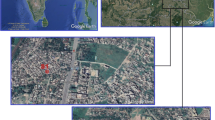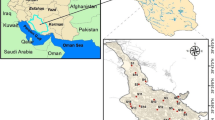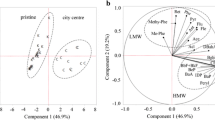Abstract
This work aimed to determine the seasonal variations of polycyclic aromatic hydrocarbons (PAHs) in airborne PM10 at two background sites (Masná—MS, Líšeň—LN) in Brno over a 5-year period (2009–2013). Samples were collected on quartz filters using a low-volume sampler by continual filtration. Concentrations of PAHs in collected PM10 samples were determined using a gas chromatography with a mass spectrometer as a detector. A different number of PAHs were determined to be at each site, i.e., 11 PAHs at the MS site and six PAHs at the LN site, and similarities between them were identified using non-parametric analysis of variance. Potential sources were identified using principal component analysis (PCA) and PAHs diagnostic ratios. The work also focused on health risk assessment. This was estimated using toxic equivalent factors to calculate individual lifetime cancer risk, which quantifies risk of exposure to PAHs for specific age groups. The average 11-PAH concentrations in M|S site annually ranged from 19.28 ± 19.02 ng m−3 (2011) to 40.37 ± 21.35 ng m−3 (2013). With regard to the LN site, the average six-PAH concentrations annually ranged from 3.64 ± 3.87 ng m−3 (2009) and 5.27 ± 6.19 ng m−3 (2012). PCA and diagnostic ratios indicate the main sources to be traffic emissions and coal combustion. Health risk assessment showed carcinogenic risk under limit value in all cases.






Similar content being viewed by others
References
Adamec V (2006) Prevention and possibilities of reduction of consequences of transportation safety risks. Habilitation thesis
Adamec V, Jedlička J, Dufek J, et al. (2007) Unlimited pollutants emitted by traffic in the Czech Republic. Bioclimatology and Natural Hazards: International Scientific Conference, Poľana nad Detvou, Slovakia
Adamec V, Huzlík J, Libčínský R, Effenberger K (2009) Dust fall measurements in road tunnels. In: Sustainable Development and Bioclimate. pp 183–184
Adamec V, Ličbinský R, Cholava R (2011) Transport and health risks of transport. Trans Trans Sc 4:115–134. doi:10.2478/v10158-011-0011-y
Air Protection Act. Act no. 201/2012 Coll. Supplement no. 1 to Act no. 201/2012 Coll. The limit and the permitted number of exceedances per calendar year
Akyüz M, Çabuk H (2008) Particle-associated polycyclic aromatic hydrocarbons in the atmospheric environment of Zonguldak, Turkey. Sci Total Environ 405:62–70. doi:10.1016/j.scitotenv.2008.07.026
Amador-Muñoz O, Bazán-Torija S, Villa-Ferreira SA, et al. (2013) Opposing seasonal trends for polycyclic aromatic hydrocarbons and PM10: health risk and sources in southwest Mexico City. Atmos Res 122:199–212. doi:10.1016/j.atmosres.2012.10.003
Brits E, Schoeters G, Verschaeve L (2004) Genotoxicity of PM10 and extracted organics collected in an industrial, urban and rural area in Flanders, Belgium. Environ Res 96:109–118. doi:10.1016/j.envres.2004.03.006
Brown AS, Brown RJC (2012) Correlations in polycyclic aromatic hydrocarbon (PAH) concentrations in UK ambient air and implications for source apportionment. J Environ Monit 14:2072–2082. doi:10.1039/c2em10963h
Bu QW, Zhang ZH, Lu S, He FP (2009) Vertical distribution and environmental significance of PAHs in soil profiles in Beijing, China. Environ Geochem Health 31:119–131. doi:10.1007/s10653-008-9171-z
Callén MS, de la Cruz MT, López JM, Mastral AM (2011) PAH in airborne particulate matter. Fuel Process Technol 92:176–182. doi:10.1016/j.fuproc.2010.05.019
Choi M, Lee M, Rhim T (2013) Dexamethasone-conjugated polyethylenimine/MIF siRNA complex regulation of particulate matter-induced airway inflammation. Biomaterials 34:7453–7461. doi:10.1016/j.biomaterials.2013.05.082
Ciganek M, Neca J, Adamec V, et al. (2004) A combined chemical and bioassay analysis of traffic-emitted polycyclic aromatic hydrocarbons. Sci Total Environ 334-335:141–148. doi:10.1016/j.scitotenv.2004.04.034
CSN EN 12341 (2000) Ambient air—standard gravimetric measurement method for the determination of the PM10 or PM2.5 mass concentration of suspended particulate matter. 24 p.
CSN EN 15549. Air quality—standard method for the measurement of the concentration of benzo[a]pyrene in ambient air. 2008. 56 p.
CSN P CEN/TS 16645 (2014) Ambient air—method for the measurement of benz[a]anthracene, benzo[b]fluoranthene, benzo[j]fluoranthene, benzo[k]fluoranthene, dibenz[a,h]anthracene, indeno[1,2,3-cd]pyrene and benzo[ghi]perylene. 56 p.
Dahle S, Savinov VM, Matishov GG, et al. (2003) Polycyclic aromatic hydrocarbons (PAHs) in bottom sediments of the Kara Sea shelf, Gulf of Ob and Yenisei Bay. Sci Total Environ 306:57–71. doi:10.1016/S0048-9697(02)00484-9
Darán AC, Gonzalez A (2009) Determination of lead, naphthalene, phenanthrene, anthracene and pyrene in street dust. International Journal of Environmental Science 6:663–670. doi: 10.1007/BF03326107
Decree No 330/2012 Coll. On the method of evaluation and assessment of the level of pollution, scope of public information about the level of pollution and during smog situations.
De Nicola F, Murena F, Costagliola MA, et al. (2013) A multi-approach monitoring of particulate matter, metals and PAHs in an urban street canyon. Environ Sci Pollut Res 20:4969–4979. doi:10.1007/s11356-012-1456-1
Directive 2008/50/EC of the European parliament and of the council of 21 May 2008 on ambient air quality and cleaner air for Europe [2008] OJ L152/1
EPA (2007) Method 610—polynuclear aromatic hydrocarbons
Franců E, Schwarzbauer J, Lána R, et al. (2010) Historical changes in levels of organic pollutants in sediment cores from Brno Reservoir, Czech Republic. Water, Air 209:81–91. doi:10.1007/s11270-009-0182-x
Gauggel-Lewandowski S, Heussner AH, Steinberg P, et al. (2013) Bioavailability and potential carcinogenicity of polycyclic aromatic hydrocarbons from wood combustion particulate matter in vitro. Chem Biol Interact 206:411–422. doi:10.1016/j.cbi.2013.05.015
Hassanien MA, Abdel-Latif NM (2008) Polycyclic aromatic hydrocarbons in road dust over Greater Cairo, Egypt. J Hazard Mater 151:247–254. doi:10.1016/j.jhazmat.2007.05.079
He J, Fan S, Meng Q, et al. (2014) Polycyclic aromatic hydrocarbons (PAHs) associated with fine particulate matters in Nanjing, China: distributions, sources and meteorological influences. Atmos Environ 89:207–215. doi:10.1016/j.atmosenv.2014.02.042
ISO 12884 (2000) Ambient air – Determination of total (gas and particle-phase) polycyclic aromatic hydrocarbons—collection on sorbent-backed filters with gas chromatographic/mass spectrometric analyses
Jamhari AA, Sahani M, Latif MT, et al. (2014) Concentration and source identification of polycyclic aromatic hydrocarbons (PAHs) in PM10 of urban, industrial and semi-urban areas in Malaysia. Atmos Environ 86:16–27. doi:10.1016/j.atmosenv.2013.12.019
Jarvis IWH, Bergvall C, Bottai M, et al. (2013) Persistent activation of DNA damage signaling in response to complex mixtures of PAHs in air particulate matter: the origin, evolution, and impact of doi moi. Toxicol Appl Pharmacol 266:408–418. doi:10.1016/j.taap.2012.11.026
Jung KH, Yan B, Chillrud SN, et al. (2010) Assessment of benzo(a)pyrene-equivalent carcinogenicity and mutagenicity of residential indoor versus outdoor polycyclic aromatic hydrocarbons exposing young children in New York City. Int J Environ Res Public Health 7:1889–1900. doi:10.3390/ijerph7051889
Katsoyiannis A, Terzi E, Cai Q-Y (2007) On the use of PAH molecular diagnostic ratios in sewage sludge for the understanding of the PAH sources. Is this use appropriate? Chemosphere 69:1337–1339. doi:10.1016/j.chemosphere.2007.05.084
Khadhar S, Higashi T, Hamdi H, et al. (2010) Distribution of 16 EPA-priority polycyclic aromatic hydrocarbons (PAHs) in sludges collected from nine Tunisian wastewater treatment plants. J Hazard Mater 183:98–102. doi:10.1016/j.jhazmat.2010.06.112
Kim D, Young TM (2009) Significance of indirect deposition on wintertime PAH concentrations in an urban Northern California Creek. Environ Eng Sci 26:269–278. doi:10.1089/ees.2007.0277
Koike E, Yanagisawa R, Takano H (2014) Toxicological effects of polycyclic aromatic hydrocarbons and their derivatives on respiratory cells. Atmos Environ 97:529–536. doi:10.1016/j.atmosenv.2014.04.003
Kong S, Shi J, Lu B, et al. (2011) Characterization of PAHs within PM10 fraction for ashes from coke production, iron smelt, heating station and power plant stacks in Liaoning Province, China. Atmos Environ 45:3777–3785. doi:10.1016/j.atmosenv.2011.04.029
Landlová L, Čupr P, Franců J, et al. (2014) Composition and effects of inhalable size fractions of atmospheric aerosols in the polluted atmosphere: part I. PAHs, PCBs and OCPs and the matrix chemical composition. Environ Sci Pollut Res 21:6188–6204. doi:10.1007/s11356-014-2571-y
Leníček J, Sekyra M, Pandey P, et al. (1997) Polycyclic aromatic hydrocarbons at ‘program Teplice’ sites in the Czech republic. Toxicol Environ Chem 58:25–32. doi:10.1080/02772249709358395
Ling W, Dang H, Liu J (2013) In situ gradient distribution of polycyclic aromatic hydrocarbons (PAHs) in contaminated rhizosphere soil: a field study. J Soils Sediments 13:677–685. doi:10.1007/s11368-013-0655-9
Liu D, Gao S, An X (2008) Distribution and source apportionment of polycyclic aromatic hydrocarbons from atmospheric particulate matter PM2.5 in Beijing. Adv Atmos Sci 25:297–305. doi:10.1007/s00376-008-0297-9
Liu J, Man R, Ma S, et al. (2015) Atmospheric levels and health risk of polycyclic aromatic hydrocarbons (PAHs) bound to PM2.5 in Guangzhou, China. Marine Pollution Bulletin. doi: 10.1016/j.marpolbul.2015.09.014
Lorenzi D, Entwistle JA, Cave M, Dean JR (2011) Determination of polycyclic aromatic hydrocarbons in urban street dust: implications for human health. Chemosphere 83:970–977. doi:10.1016/j.chemosphere.2011.02.020
Machala M, Vondráček J, Bláha L, et al. (2001) Aryl hydrocarbon receptor-mediated activity of mutagenic polycyclic aromatic hydrocarbons determined using in vitro reporter gene assay. Mutat Res/Genet Toxicol Environ Mutagen 497:49–62. doi:10.1016/S1383-5718(01)00240-6
Mantis J, Chaloulakou A, Samara C (2005) PM10-bound polycyclic aromatic hydrocarbons (PAHs) in the greater area of Athens, Greece. Chemosphere 59:593–604. doi:10.1016/j.chemosphere.2004.10.019
Masih A, Saini R, Singhvi R, Taneja A (2010) Concentrations, sources, and exposure profiles of polycyclic aromatic hydrocarbons (PAHs) in particulate matter (PM10) in the north central part of India. Environ Monit Assess 163:421–431. doi:10.1007/s10661-009-0846-4
Masih J, Singhvi R, Taneja A, et al. (2012) Gaseous/particulate bound polycyclic aromatic hydrocarbons (PAHs), seasonal variation in north central part of rural India. Sustain Cities Soc 3:30–36. doi:10.1016/j.scs.2012.01.001
Masiol M, Hofer A, Squizzato S, et al. (2012) Carcinogenic and mutagenic risk associated to airborne particle-phase polycyclic aromatic hydrocarbons: a source apportionment. Atmos Environ 60:375–382. doi:10.1016/j.atmosenv.2012.06.073
Mastral A, Lopez J, Callen M, et al. (2003) Spatial and temporal PAH concentrations in Zaragoza, Spain. Sci Total Environ 307:111–124. doi:10.1016/S0048-9697(02)00460-6
Mohanraj R, Solaraj G, Dhanakumar S (2011) Fine particulate phase PAHs in ambient atmosphere of Chennai metropolitan city, India. Environ Sci Pollut Res 18:764–771. doi:10.1007/s11356-010-0423-y
Morman SA, Plumlee GS (2013) The role of airborne mineral dusts in human disease. Aeolian Res 9:203–212. doi:10.1016/j.aeolia.2012.12.001
Mostafa AR, Hegazi AH, El-Gayar MS, Andersson JT (2009) Source characterization and the environmental impact of urban street dusts from Egypt based on hydrocarbon distributions. Fuel 88:95–104. doi:10.1016/j.fuel.2008.08.006
Nehyba S, Hilscherová K, Jarkovský J, et al. (2010) Grain size, geochemistry and organic pollutants in modern fluvial deposits in eastern Moravia (Czech Republic). Environ Earth Sci 60:591–602. doi:10.1007/s12665-009-0199-x
OEHHA—Office of Environmental Health Hazard Assessment (2009) Technical Support Document for Cancer Potency Factors: Methodologies for derivation, listing of available values, and adjustments to allow for early life stage exposures: Appendix A: Hot Spots Unit Risk and Cancer Potency Values. http://www.oehha.org/air/hot_spots/2009/AppendixA.pdf
Orona NS, Astort F, Maglione GA, et al. (2014) Direct and indirect air particle cytotoxicity in human alveolar epithelial cells. Toxicol in Vitro 28:796–802. doi:10.1016/j.tiv.2014.02.011
Ozaki N, Takemoto N, Kindaichi T (2010) Nitro-PAHs and PAHs in atmospheric particulate matters and sea sediments in Hiroshima Bay Area, Japan. Water Air Soil Pollut 207:263–271. doi:10.1007/s11270-009-0134-5
Pandey PK, Patel KS, Lenicek J (1999) Polycyclic aromatic hydrocarbons: need for assessment of health risks in India? Study of an urban-industrial location in India. Environmental Monitoring and Assessment 59:287–319. doi: 10.1023/A:1006169605672
Park SS, Kim YJ, Kang CH (2002) Atmospheric polycyclic aromatic hydrocarbons in Seoul, Korea. Atmos Environ 36:2917–2924. doi:10.1016/S1352-2310(02)00206-6
Pies C, Hoffmann B, Petrowsky J, et al. (2008) Characterization and source identification of polycyclic aromatic hydrocarbons (PAHs) in river bank soils. Chemosphere 72:1594–1601. doi:10.1016/j.chemosphere.2008.04.021
Plachá D, Raclavská H, Matýsek D, Rümmeli MH (2009) The polycyclic aromatic hydrocarbon concentrations in soils in the region of Valasske Mezirici, the Czech Republic. Geochemical Transactions 10:12-. doi: 10.1186/1467–4866–10-12
Prokeš R, Vrana B, Komprdová K, Klánová J (2014) Annual dynamics of persistent organic pollutants in various aquatic matrices: a case study in the Morava River in Zlín district, Czech Republic. J Soils Sediments. doi:10.1007/s11368-014-0931-3
Ravindra K, Sokhi R, Vangrieken R (2008) Atmospheric polycyclic aromatic hydrocarbons: source attribution, emission factors and regulation. Atmos Environ 42:2895–2921. doi:10.1016/j.atmosenv.2007.12.010
Rehwagen M, Müller A, Massolo L, et al. (2005) Polycyclic aromatic hydrocarbons associated with particles in ambient air from urban and industrial areas. Sci Total Environ 348:199–210. doi:10.1016/j.scitotenv.2004.12.050
Saeedi M, Li LY, Salmanzadeh M (2012) Heavy metals and polycyclic aromatic hydrocarbons: pollution and ecological risk assessment in street dust of Tehran. J Hazard Mater 227-228:9–17. doi:10.1016/j.jhazmat.2012.04.047
Shang J, Chen J, Shen Z, et al. (2015) Photochemical degradation of PAHs in estuarine surface water: effects of DOM, salinity, and suspended particulate matter. Environ Sci Pollut Res 22:12374–12383. doi:10.1007/s11356-015-4543-2
Shi G-L, Feng Y-C, Wu J-H, et al. (2009) Source identification of polycyclic aromatic hydrocarbons in urban particulate matter of Tangshan. China Aerosol and Air Qual Res. doi:10.4209/aaqr.2008.12.0063
Singare PU (2015) Studies on polycyclic aromatic hydrocarbons in surface sediments of Mithi River near Mumbai, India: assessment of sources, toxicity risk and biological impact. Mar Pollut Bull. doi:10.1016/j.marpolbul.2015.09.057
Slezakova K, Castro D, Delerue-Matos C, et al. (2013) Impact of vehicular traffic emissions on particulate-bound PAHs: levels and associated health risks. Atmos Res 127:141–147. doi:10.1016/j.atmosres.2012.06.009
Teixeira EC, Agudelo-Castañeda DM, Fachel JMG, et al. (2012) Source identification and seasonal variation of polycyclic aromatic hydrocarbons associated with atmospheric fine and coarse particles in the metropolitan area of Porto Alegre, RS, Brazil. Atmos Res 118:390–403. doi:10.1016/j.atmosres.2012.07.004
Tobiszewski M, Namieśnik J (2012) PAH diagnostic ratios for the identification of pollution emission sources. Environ Pollut 162:110–119. doi:10.1016/j.envpol.2011.10.025
US EPA (2011) Exposure factors handbook. U.S. Environmental Protection Agency, Washington, DC
US EPA TO-13A (1999) Compendium method TO-13A determination of polycyclic aromatic hydrocarbons (PAHs) in ambient air using gas chromatography/mass spectrometry (GC/MS)
Villar-Vidal M, Lertxundi A, Martinez López de Dicastillo MD, et al. (2014) Air polycyclic aromatic hydrocarbons (PAHs) associated with PM2.5 in a North Cantabric coast urban environment. Chemosphere 99:233–238. doi:10.1016/j.chemosphere.2013.11.006
Wang J, Geng NB, Xu YF, et al. (2014) PAHs in PM2.5 in Zhengzhou: concentration, carcinogenic risk analysis, and source apportionment. Environ Monit Assess 186:7461–7473. doi:10.1007/s10661-014-3940-1
Wang W, Massey Simonich SL, Xue M, et al. (2010) Concentrations, sources and spatial distribution of polycyclic aromatic hydrocarbons in soils from Beijing, Tianjin and surrounding areas, North China. Environ Pollut 158:1245–1251. doi:10.1016/j.envpol.2010.01.021
Wang W, M-juan H, Kang Y, et al. (2011) Polycyclic aromatic hydrocarbons (PAHs) in urban surface dust of Guangzhou, China: status, sources and human health risk assessment. Sci Total Environ 409:4519–4527. doi:10.1016/j.scitotenv.2011.07.030
Wiriya W, Prapamontol T, Chantara S (2013) PM10-bound polycyclic aromatic hydrocarbons in Chiang Mai (Thailand): seasonal variations, source identification, health risk assessment and their relationship to air-mass movement. Atmos Res 124:109–122. doi:10.1016/j.atmosres.2012.12.014
Xue X, You Y, Wu J, et al. (2014) Exposure measurement, risk assessment and source identification for exposure of traffic assistants to particle-bound PAHs in Tianjin, China. J Environ Sci 26:448–457. doi:10.1016/S1001-0742(13)60427-1
Yunker MB, Macdonald RW, Vingarzan R, et al. (2002) PAHs in the Fraser River basin: a critical appraisal of PAH ratios as indicators of PAH source and composition. Org Geochem 33:489–515. doi:10.1016/S0146-6380(02)00002-5
Zereini F, Wiseman CL (2010) Urban airborne particulate matter: origin, chemistry, fate, and health impacts. Springer, New York
Zhang XL, Tao S, Liu WX, et al. (2005) Source diagnostics of polycyclic aromatic hydrocarbons based on species ratios: a multimedia approach. Environ Sci 39:9109–9114. doi:10.1021/es0513741
Zhang W, Zhang S, Wan C, et al. (2008) Source diagnostics of polycyclic aromatic hydrocarbons in urban road runoff, dust, rain and canopy throughfall. Environ Pollut 153:594–601. doi:10.1016/j.envpol.2007.09.004
Zhao H, Yin C, Chen M, et al. (2009) Size distribution and diffuse pollution impacts of PAHs in street dust in urban streams in the Yangtze River Delta. J Environ Sci 21:162–167. doi:10.1016/S1001-0742(08)62245-7
Acknowledgments
This work is an output of research and scientific activities of this project LO1202 with financial support from the MEYS under the program NPU I.
Author information
Authors and Affiliations
Corresponding author
Additional information
Responsible editor: Constantini Samara
Rights and permissions
About this article
Cite this article
Bulejko, P., Adamec, V., Schüllerová, B. et al. Levels, sources, and health risk assessment of polycyclic aromatic hydrocarbons in Brno, Czech Republic: a 5-year study. Environ Sci Pollut Res 23, 20462–20473 (2016). https://doi.org/10.1007/s11356-016-7172-5
Received:
Accepted:
Published:
Issue Date:
DOI: https://doi.org/10.1007/s11356-016-7172-5




